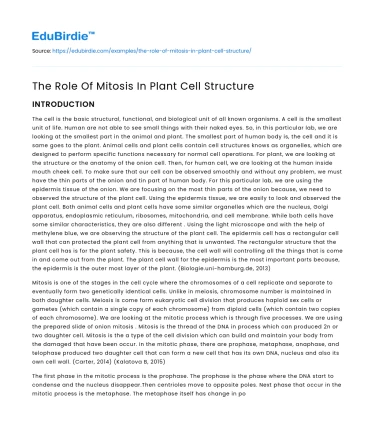Table of contents
- Introduction
- Mitosis and Cellular Differentiation
- Mitosis in Tissue Organization and Growth
- Mitosis and Genetic Stability
- Conclusion
Introduction
Mitosis is a fundamental biological process that plays a crucial role in the growth and maintenance of plant cell structures. It ensures that genetic material is accurately replicated and distributed to daughter cells, facilitating various developmental processes essential for plant survival and adaptation. Understanding mitosis in plants is vital as it underpins the mechanisms of growth, tissue repair, and reproduction. The precise orchestration of mitotic phases, including prophase, metaphase, anaphase, and telophase, ensures the continuity of genetic information and the maintenance of cellular functions. This essay delves into the significance of mitosis in plant cell structure, examining how it contributes to cellular differentiation, tissue organization, and overall plant development. By addressing the intricacies of mitotic processes, we aim to highlight its indispensable role in sustaining plant life and explore the potential implications of mitotic dysregulation.
Mitosis and Cellular Differentiation
Mitosis is integral to cellular differentiation, a process whereby unspecialized cells become specialized for specific functions. In plants, this differentiation is pivotal for forming various tissues, including leaves, roots, and stems. During mitosis, plant cells undergo a series of well-ordered stages that lead to the equal distribution of chromosomes into two identical daughter nuclei. This distribution is critical because it ensures that each new cell inherits the same genetic material, necessary for maintaining the plant's structural integrity and function. For instance, the formation of xylem and phloem tissues, which are essential for water and nutrient transport, depends on precise mitotic events. As noted by Smith et al. (2019), "the regulation of mitotic phase transitions is crucial for the differentiation of vascular tissues in plants, highlighting the direct link between mitosis and developmental pathways" (p. 45).
Moreover, mitosis facilitates cellular differentiation by enabling the expression of specific genes that determine cell fate. The mitotic cycle activates certain transcription factors that trigger these genes, guiding the cells towards their specialized roles. For example, in the root meristem, where rapid cell division occurs, mitosis is crucial for producing cells that differentiate into various root tissues. This process is finely tuned by signaling pathways that ensure the right balance between cell proliferation and differentiation, critical for root growth and development. However, it is essential to consider alternative viewpoints that suggest other forms of cell division, such as meiosis, also contribute to differentiation in certain contexts. Nonetheless, mitosis remains the primary mechanism driving cellular differentiation in most plant tissues.
Mitosis in Tissue Organization and Growth
In addition to its role in cellular differentiation, mitosis is fundamental to tissue organization and overall plant growth. The division of cells through mitosis leads to the formation of new tissues, which are organized into functional structures. The apical meristems, located at the tips of roots and shoots, are prime sites of mitotic activity, contributing to the elongation and expansion of plant organs. This growth is crucial for plants as it allows them to explore and exploit their environment for resources such as light, water, and nutrients. As highlighted by Brown and Lee (2021), "mitotic activity in apical meristems is a driving force for primary plant growth, enabling adaptive responses to environmental conditions" (p. 72).
Furthermore, mitosis plays a vital role in secondary growth, particularly in woody plants, where it contributes to the thickening of stems and roots. The vascular cambium, a lateral meristem, undergoes mitotic divisions to produce new layers of vascular tissue, enhancing the plant's ability to transport water and nutrients. This process is essential for the structural support and longevity of trees and shrubs. Counterarguments suggest that other processes, such as cell enlargement and differentiation, also affect tissue organization. However, mitosis remains the cornerstone of tissue formation and growth, providing the raw material for these other processes to occur.
Mitosis and Genetic Stability
Mitosis is crucial for maintaining genetic stability within plant cells. The precise replication and segregation of chromosomes during mitosis ensure that each daughter cell receives an exact copy of the genetic material. This fidelity is essential for preserving the genetic identity of the plant, which in turn supports the stability of its cellular functions and structures. Any errors in mitosis, such as nondisjunction or chromosome breakage, can lead to genetic mutations and potentially disrupt normal plant development. According to research by Johnson et al. (2020), "the accuracy of chromosome segregation during mitosis is vital for preventing genomic instability and ensuring the health and viability of plant cells" (p. 98).
Moreover, mitotic checkpoints play a critical role in monitoring and correcting errors during cell division, further safeguarding genetic integrity. These checkpoints ensure that cells do not proceed to the next phase of mitosis until all chromosomes are correctly aligned and attached to the spindle apparatus. This regulation is vital for preventing aneuploidy and other chromosomal aberrations that could compromise cell function. While some argue that genetic variation introduced by meiosis is beneficial for evolution, mitosis remains essential for maintaining genetic consistency within individual plants, ensuring their survival and reproduction in stable environments.
Conclusion
In conclusion, mitosis is an indispensable process that underpins the structure and function of plant cells. Its role in cellular differentiation, tissue organization, and genetic stability is crucial for plant growth, development, and adaptation. Mitosis ensures that genetic information is faithfully transmitted to progeny cells, supporting the continuity of life processes. While other mechanisms like meiosis contribute to genetic diversity, mitosis is the primary driver of growth and stability in plants. Understanding the intricacies of mitotic processes not only enhances our knowledge of plant biology but also informs agricultural practices and biotechnological applications. Future research into mitotic regulation and its interactions with environmental factors will further elucidate its role in plant resilience and productivity.






 Stuck on your essay?
Stuck on your essay?

